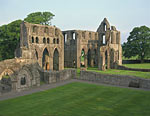
Battle of Langside
Having escaped from Loch Leven Castle on May 2nd 1568, Mary headed for Dumbarton Castle which Lord Fleming was holding for her. Her half brother, Lord James Stewart, realised what she was trying to do and moved his forces to intercept her.
The Queen's army numbered some 6,000 while the opposition was 4,500. However the leaders had much more military experience. Moray had fought in several home wars and Morton, Semple, Home and Lindsay had foreign experience as well. The Queen's army started to move along the south bank of the Clyde toward Dumbarton on the May 13th. The village of Langside is very close to Glasgow and it became obvious that the confrontation would occur here. The main road passed through a cluster of small houses on either side of the road where it crossed the hill but the Queen's army did not try to secure the area before advancing. The opposition became aware of this fundamental military error and Kirkcaldy sent 200 troops across the river each with an archer. The latter reached the houses before the Queen's troops arrived and concealed themselves. The Queen's army stopped on a small hill to the east of the village and in spite of having 16 cannon could make no impression on the concealed archers or on the main body drawn up to the west of the village. Lord Arbroath's vanguard of the Queen's forces stormed the village but was met by an equal force from the Regent's men.
At this stage in the development of warfare each soldier was encased in a suit of impregnable armour, which led to stale-mate. The spears of each rank of soldiers stuck in the joints of the armour of the opposite ranks and they all became locked together. They were not fighting but had just become a human barrier. Those behind threw rocks and other missiles over the heads of the front ranks but these just landed on the rows of spears and added to the barrier. The Queen's forces became unsteady. Seeing this, Grange charged them and they broke up and fled. The Regent's forces were under orders to spare as many as possible and so only 300 were killed while the Regent lost only one man.The whole skirmish lasted only three quarters of an hour but the event was very decisive and settled the fate of Scotland.
When the Queen saw what was happening she galloped off and fled from her friends as well as her enemies. There is speculation that she spent the next two nights at Sanquhar and then Terregles before arriving at Dundrennan Abbey on May 15th 1568, where she spent her last night in Scotland. She was en-route to England to appeal to her cousin, Elizabeth, for support. On the 16th she embarked in an open fishing-boat, landed on the same day and made her way to Workington, in Cumberland.